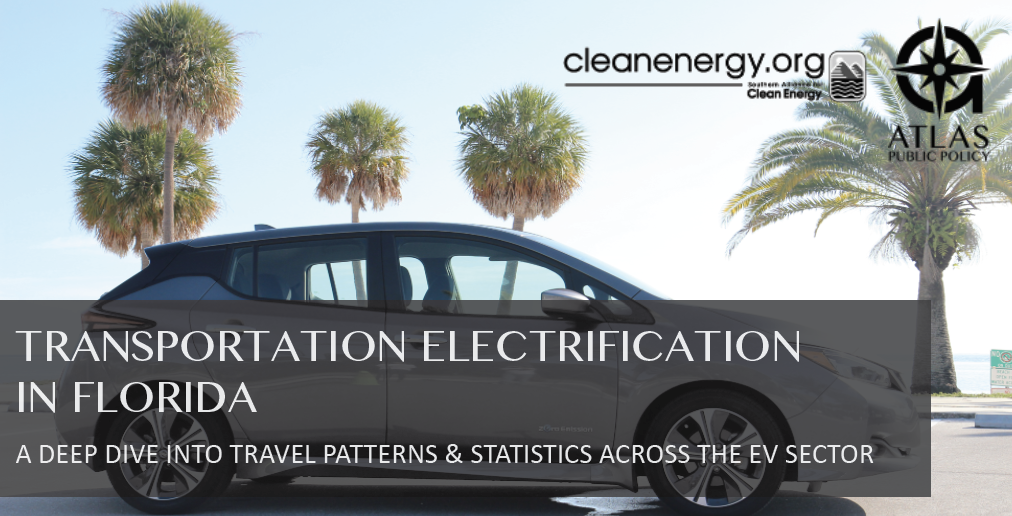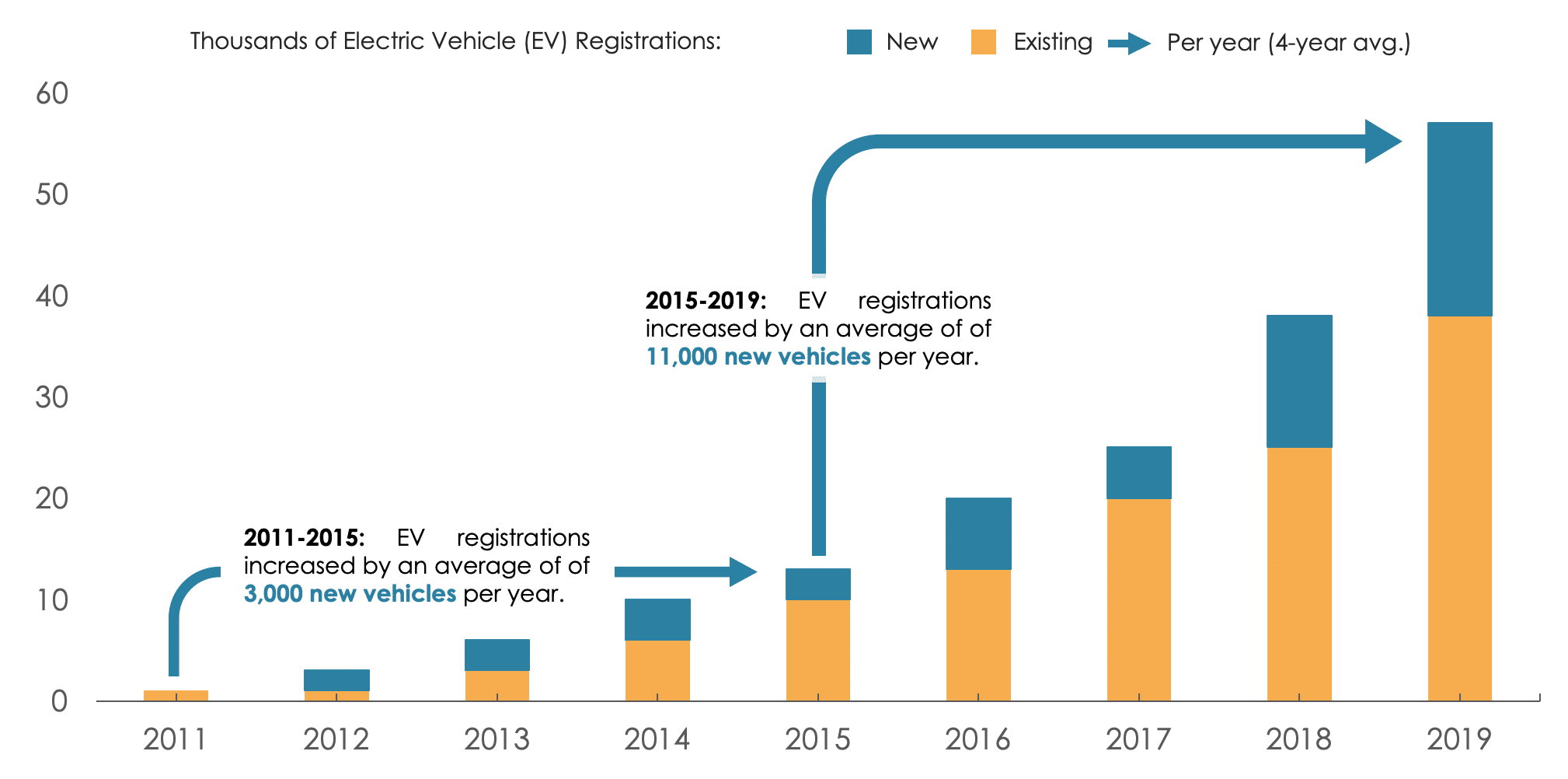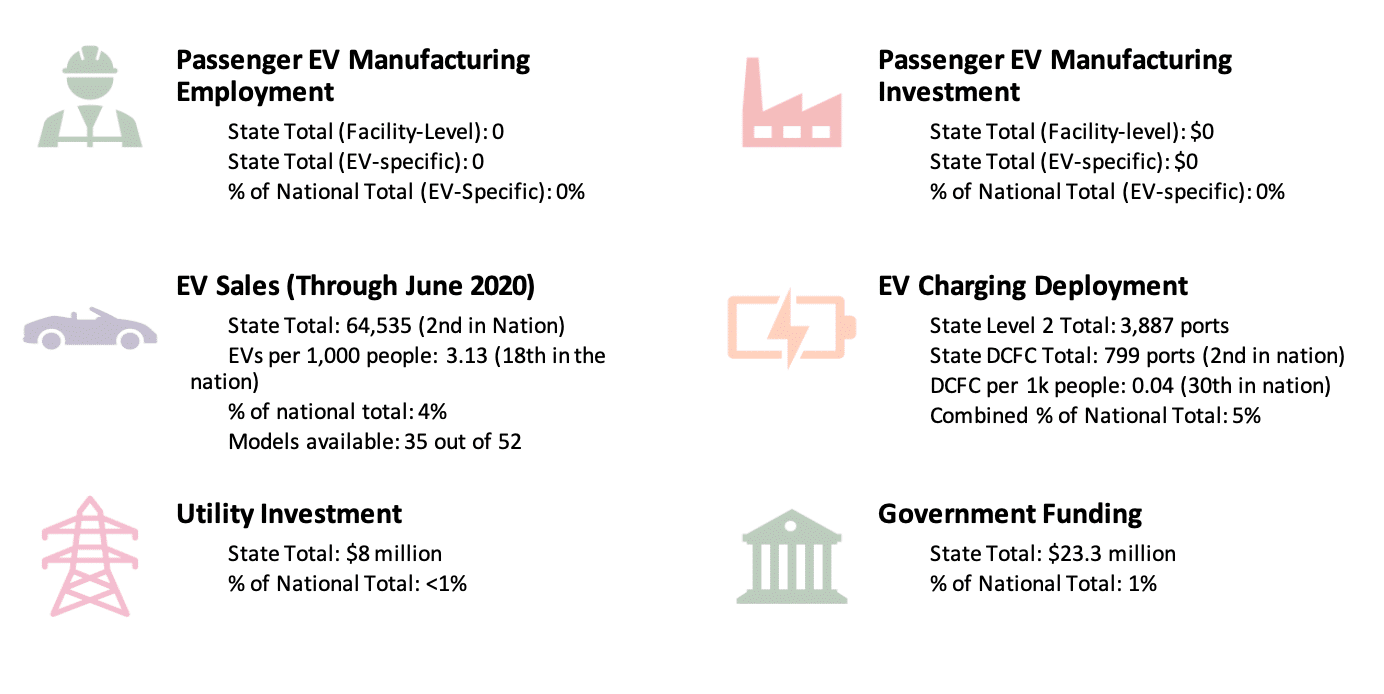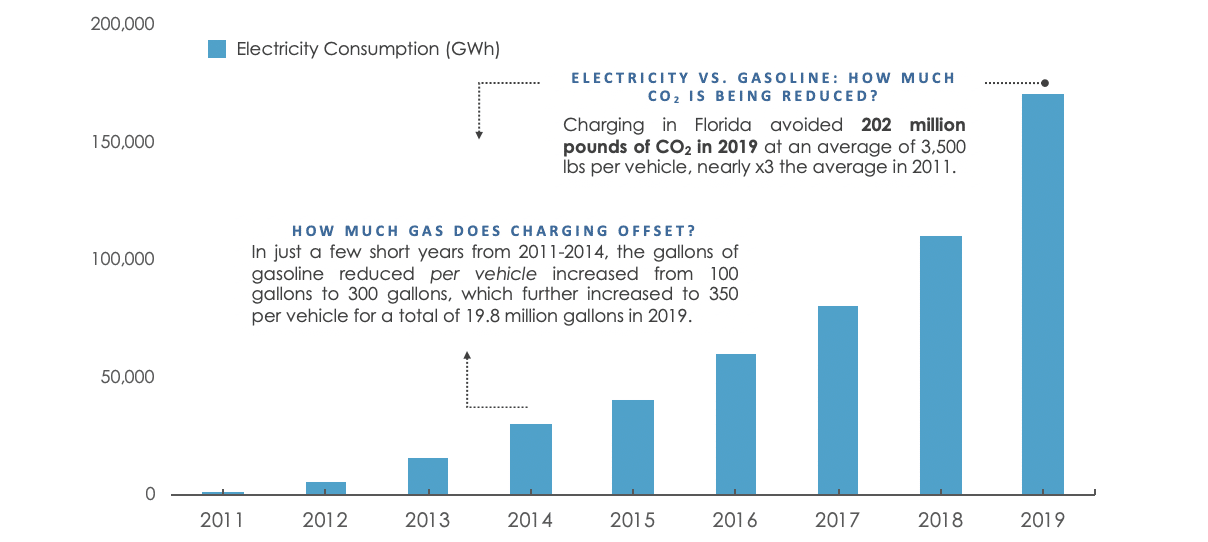Florida is #2 in the nation in electric vehicle (EV) sales, but near the bottom in government and utility investment. The state also lags other states in EV charger deployment. Utility engagement and supportive state policies are needed to ensure Floridians can fully access the economic, public health, and climate benefits that EVs deliver.
Stan Cross | October 15, 2020 | Clean Transportation, Electric Vehicles, FloridaStates across the country, including Florida, are seizing the opportunity to increase EVs and EV charging stations. Cumulatively, 1.6 million passenger EVs have been sold, and investment in the EV sector is on the rise. Transportation electrification is taking hold in the United States across all vehicle types, including consumer vehicles, fleets, electric buses, and trucks.
To explore how Florida stacks up against other states, the Southern Alliance for Clean Energy (SACE) and Atlas Public Policy have collaborated on a new brief, “Transportation Electrification in Florida.” The new brief follows the recent “Transportation Electrification in the Southeast” brief, also a collaboration between SACE and Atlas, that examined state policy, regulatory, economic development, and investment activity across the Southeast. The Florida-specific brief provides a snapshot of Florida’s EV market, transportation patterns, policy environment, and opportunities to improve public health, meet climate change goals, and spur economic growth.
This blog is the first in a series examining the study’s findings. Upcoming blogs will look in greater detail at how lawmakers, public agencies, utilities, and regulators can advance policies to accelerate engagement and investment, enabling all Floridians to access electric transportation and its related economic, public health, and climate benefits.

Download the Brief
Read the Blog Series
Nationwide, the EV Market is Accelerating
The U.S. passenger EV market has accelerated rapidly over the last decade, reaching 1.6 million vehicles sold nationally through Q2 2020. More than 52 models of EVs are available nationally on the market, up dramatically from just two in 2010, with at least 30 more expected by the end of 2021. Automakers and startups have pledged at least $64 billion to support transportation electrification in the United States.
The market for EV charging infrastructure has grown in step with the vehicle market. Since the beginning of 2018, the number of charging stations nationwide has almost tripled. Nearly 91,000 charging ports are deployed at about 30,000 locations throughout the United States, and electric utilities have committed more than $1.8 billion to programs dedicated to EV charging since 2012. Additionally, private companies have invested roughly $2.8 billion to expand the nation’s charging networks, and the federal and state governments have allocated more than $2.1 billion to transportation electrification.
The Florida EV Market is Ripe
Florida is #2 in the nation in passenger EV sales. As of June 2020, there were roughly 64,500 EVs on Florida’s roads. EV sales in the state increased by 20% between 2018 and 2019, despite a 12% drop in EV sales nationwide during the same period. However, when looked at on a per capita basis, Florida ranks 18th nationally in EV sales, indicating significant room for market growth.
Florida lags other states in the nation in government and utility funding for transportation electrification and per capita deployment of EV charging infrastructure. Florida’s Public Service Commission approved utility investments represent less-than-1% of utility investments nationwide, state government spending represents approximately 1% of state spending nationwide, and Florida ranks 3oth in EV charger deployment per capita. Activating state and utility engagement and building out needed charging stations will further advance Florida’s EV market leadership and help provide Floridians access to the economic, public health, and climate benefits of electric transportation.
FLORIDA EV MARKET EXCEEDS NATIONAL TRENDS

EV INDICATORS IN FLORIDA THROUGH AUGUST 2020

Florida accounts for seven percent of the national population, with 21,477,737 people. On a per-person basis, the state is behind on all EV indicators compared to the national total. The state has no reported direct investment or employment in EV manufacturing.
State-Wide EV Planning is Underway
With the passage of Senate Bill 7018, the Florida Legislature and Governor DeSantis took the first step in activating state and utility engagement. The state law tasks the Public Service Commission (PSC), Department of Transportation (DOT), and the state Energy Office to lead the creation of an EV master plan. With the support of industry stakeholders, these agencies will research EV charging needs along highway corridors and evacuation routes, determine how to best engage the state’s investor-owned utilities (IOUs), and chart an infrastructure implementation path that will support consumer and fleet EV adoption. This state-level planning process places Florida in an elite class of states thinking strategically about the future of mobility.
Indirect Economic Development Opportunities for Florida
Whereas other Southeastern states with an established manufacturing industry will benefit from direct EV industry investments and job growth, Florida currently lacks direct EV manufacturing investment and job growth opportunities. Florida’s economic development opportunities are therefore more indirect, and include EV-related tourism and economic activity related to improved public health, reduced climate risk, and lower-cost mobility for residents and fleet operators:
- According to a recent report by the American Lung Association, transitioning to an all-electric fleet nationwide by 2050 would save 6,300 lives and cut greenhouse gas emissions by 1.4 billion metric tons. It would also save $72 billion in healthcare costs nationally, including $3.7 billion in Florida.
- Consumer Reports’ recent white paper analyzed real-world maintenance and repair cost data from thousands of CR members and found that owning an electric vehicle will save the typical driver $6,000 to $10,000 over the vehicle’s life compared to owning a comparable gas-powered vehicle. Hence, converting state and local government fleets will create significant long-term taxpayer savings.
Furthermore, Florida has the opportunity to retain consumer wealth. The state lacks oil production and processing facilities, so is required to import gas and diesel to fuels its economy. When consumers and fleet operators purchase gas at the pump, nearly all of the post-tax dollars spent are siphoned away from Florida to oil company corporate headquarters and foreign nations. In contrast, when Florida’s EV drivers buy locally produced electricity to fuel their mobility, they pay less (leaving dollars in their pocket to spend elsewhere), AND what they do spend goes to Florida-based utilities. Additionally, Florida’s utility mix gets cleaner every day as coal is replaced with natural gas and renewable energy installations surge, further enhancing EV climate benefits.
ELECTRICITY CONSUMED FROM EV CHARGING IN FLORIDA

This chart shows the growth in electricity consumption as a result of increased EV adoption in Florida. EVs are reducing the carbon intensity of vehicles because electricity consumed from charging is far cleaner than the gasoline used to power conventional passenger vehicles.
Florida Can Become a National Electric Transportation Leader
Florida policymakers and regulators can build upon the state’s strong EV sales to implement supportive policies, engage utilities, and direct state funding to further advance transportation electrification. The second blog in the “Transportation Electrification in Florida” series, Transportation Electrification in Florida: Leveraging Utility Engagement, looks at how policymakers and regulators can encourage utility engagement and investment to scale infrastructure deployment and enable market acceleration. The third blog in the series, Transportation Electrification in Florida: State Policies Will Drive Growth, looks at state policies Florida legislators, the Governor’s office, and state agencies can implement to support Floridians’ access to electric transportation and related economic, public health, and climate benefits.
Check out the other blogs in this series:
Read Part 2, “Transportation Electrification in Florida: Leveraging Utility Engagement,” which addresses how utility engagement and investment can accelerate Florida’s transition to electric transportation.
Read Part 3, “Transportation Electrification: State Policies Will Drive Growth,” which addresses the state policies Florida lawmakers can implement to support equitable access to electric transportation.
The Southern Alliance for Clean Energy’s ‘Electrify the South’ campaign advocates for a shift to clean, electric transportation throughout the Southeast. Visit ElectrifytheSouth.org to learn more and connect with us.
#EVsinFL